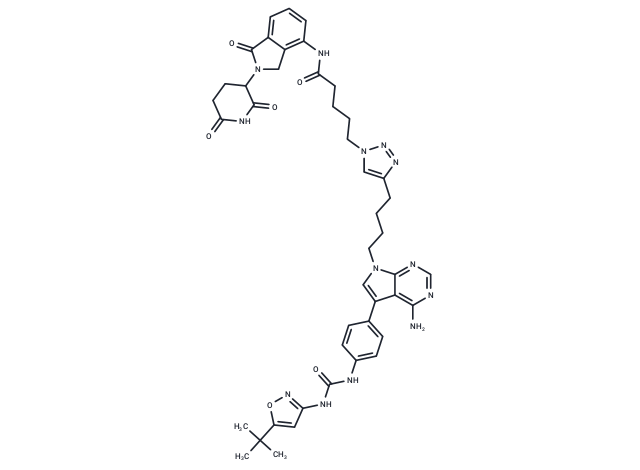Shopping Cart
- Remove All
 Your shopping cart is currently empty
Your shopping cart is currently empty

PF15, a selective FLT3-ITD degrader, serves as a PROTAC (proteolysis targeting chimera) tethering ligands for FLT3 kinase and CRBN. It exhibits a degradation concentration 50 (DC50) of 76.7 nM and notably impedes the proliferation of FLT3-ITD-positive cells. PF15 also reduces phosphorylation levels of FLT3 and STAT5 and demonstrates efficacy in inhibiting tumor growth in mouse models, suggesting potential applications in leukemia research [1].

| Pack Size | Price | Availability | Quantity |
|---|---|---|---|
| 5 mg | Inquiry | Backorder | |
| 50 mg | Inquiry | Backorder |
| Description | PF15, a selective FLT3-ITD degrader, serves as a PROTAC (proteolysis targeting chimera) tethering ligands for FLT3 kinase and CRBN. It exhibits a degradation concentration 50 (DC50) of 76.7 nM and notably impedes the proliferation of FLT3-ITD-positive cells. PF15 also reduces phosphorylation levels of FLT3 and STAT5 and demonstrates efficacy in inhibiting tumor growth in mouse models, suggesting potential applications in leukemia research [1]. |
| In vitro | PF15, at concentrations ranging from 0-1000 nM over 72 hours, demonstrates significant anti-proliferative effects against MV4-11, Molm-13, and BaF3 cells harboring ITD, ITD-D835V, and ITD-F691L mutations, respectively [1]. At increasing doses (1-1000 nM for 6 hours), PF15 markedly promotes FLT3 degradation, with the 10-1000 nM concentrations for 6 hours also substantially inhibiting FLT3 and STAT5 phosphorylation in BaF3-FLT3-ITD cells [1]. Further, PF15 significantly reduces FLT3 and STAT5 phosphorylation, particularly at 100 nM for 6 hours, in both BaF3-FLT3-ITD-D835V and BaF3-FLT3-ITD-F691L cells [1]. Time-dependent FLT3 degradation is observed with 100 nM PF15 treatment over 1 to 24 hours [1]. Additionally, PF15 induces FLT3 degradation across a broad concentration range (15.6-2000 nM for 24 hours), achieving a DC50 of 76.7 nM [1]. |
| In vivo | PF15 administered intraperitoneally at dosages of 10 mg/kg and 20 mg/kg once daily for 10 days exhibited substantial tumor growth inhibition, with a 58.4% inhibition rate at the lower dose and a higher rate at the increased dose [1]. When given at 20 mg/kg twice daily or 40 mg/kg once daily over 12 days, PF15 extended the median survival time to 15 days compared to 11 days in the negative control group in a BaF3-FLT3-ITD in situ model [1]. |
| Molecular Weight | 855.94 |
| Formula | C44H49N13O6 |
| Cas No. | 2892631-70-6 |
| Storage | Powder: -20°C for 3 years | In solvent: -80°C for 1 year | Shipping with blue ice. |

Copyright © 2015-2025 TargetMol Chemicals Inc. All Rights Reserved.